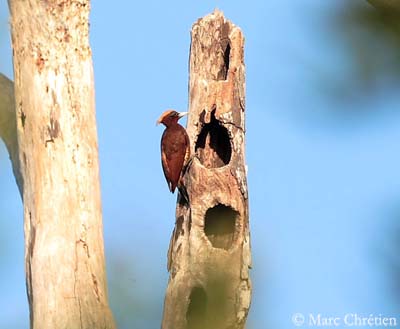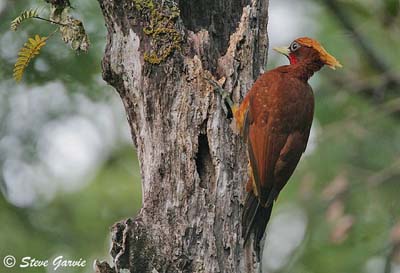
Chestnut Woodpecker
Celeus elegans
Piciforme Order – Picidae Family
BIOMETRICS:
Length: 26-30 cm, Weight: 127 g
DESCRIPTION:
Chestnut Woodpecker is a large bird and a noisy species.
Adult male has rufous-chestnut upperparts, with cream-buff rump and upper tail coverts. On the wings, coverts are rufous-chestnut with small white spots. Alula area is creamy-coloured. Flight feathers are darker and browner. Upper tail is rather blackish.

On the underparts, chin throat, breast, belly and vent are dark chestnut, sometimes paler on vent. Flanks are creamy-cinnamon. Underwings are buffy-cream with browner flight feathers. Undertail feathers are dark brown to blackish.
On the head, we can see conspicuous buffy-cream long crest. Crown and forehead are buffy-cream too. It has red malar patch and cheeks. Rest of the head is chestnut-brown.
Short bill with curved culmen is ivory to yellowish, often with darker tip. Eyes are reddish-brown, with blue-grey eye-ring. Legs and feet are greyish.
Female is almost similar, but she lacks the red malar patch.
Juvenile resembles adults with dull blackish face and mottled underparts. Young male has red malar patch very soon.
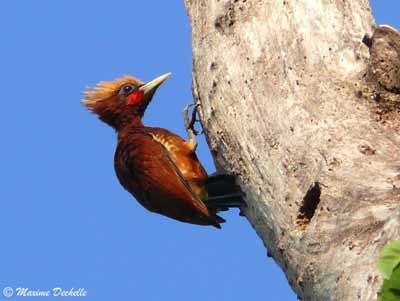
Woodpeckers roost in tree holes where they are protected from predators and bad weather. It threatened at roost, it presses its body against the bottom of the cavity. If attacked, it spreads the wings and uses its bill as a weapon. When at nest, it utters alarm calls if predator is close, and it can attack it.
Breeding season is time for frequent drumming by both sexes and several displays are performed.
FLIGHT:
Chestnut Woodpecker is good flier, but as most of woodpeckers, it performs only short distance movements. Wings can produce some sounds in the flapping phase of bounding flight.
Fluttering aerial displays and audible wing beats when excited also produce non-vocal sounds.
REPRODUCTION:
Breeding season varies according to the location.
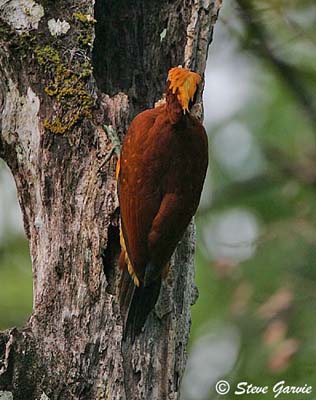
Chestnut Woodpecker nests in cavity carved into the wood of a dead tree. Usually, nest chamber is unlined, or only with some wood ships remaining at the bottom after excavation. Both sexes excavate first the entrance, then there is a deep tunnel, and at the end, the nest chamber is dug in softer wood, at about 30 cm below the entrance.
Female lays 3 white eggs.
Breeding behaviour of Chestnut Woodpecker is unknown, but incubation probably lasts between 11 and 21 days, usually between 9 to 14 days, shared by both parents. Young fledge at about 18 to 35 days after hatching.
DIET:
Chestnut Woodpecker feeds usually on ants and termites, but mainly on fruits and berries, often in large quantities.
It feeds in trees and bushes, in bark crevices.
PROTECTION / THREATS / STATUS:
Chestnut Woodpecker is relatively common in several parts of its range. This species is not globally threatened, but woodpeckers can be preyed upon by raptors when out of their cavities.
Fr: Pic mordoré
All : Fahlkopfspecht
Esp : Carpintero Elegante
Ital : Picchio castano maggiore
Nd : Vaalkuifspecht
Photographs by Steve Garvie
His website: RAINBIRDER Photo galleries
Photographs by Marc Chrétien
His website : MURINUS
Photograph by Maxime Dechelle
His website: LEPAPARRAZO
Text by Nicole Bouglouan
Sources :
HANDBOOK OF THE BIRDS OF THE WORLD Vol. 7 by Josep del Hoyo-Andrew Elliott-Jordi Sargatal – Lynx Edicions – ISBN: 8487334377
A GUIDE TO THE BIRDS OF MEXICO AND NORTHERN CENTRAL AMERICA by Steve N. G. Howell, Sophie Webb - Oxford University Press - ISBN: 0198540124
We find some subspecies:
C.e. hellmayri lives in E Venezuela, Guyana and Suriname. It has darker plumage and crown, and more whitish spots on wings and scapulars.
C.e. leotaudi, from Trinidad, is smaller and paler.
C.e. deltanus, from NE Venezuela, has darker crown.
C.e. elegans, from E Suriname, French Guiana and N Brazil.
C.e. jumanus, from parts of Colombia, Venezuela, Brazil and Bolivia, is darker.
C.e. citreopygius, from Ecuador and Peru, is blacker with shorter crest.
VOICE: SOUNDS BY XENO-CANTO
Chestnut Woodpecker is very noisy. It utters several kinds of harsh calls such as “wewa ew-ew-ew…” descending in tone; sarcastic “har-hahaha” is a territorial call; rattling screeches and other grating repeated calls.
Male and female drum frequently during breeding season, male more frequently than female.
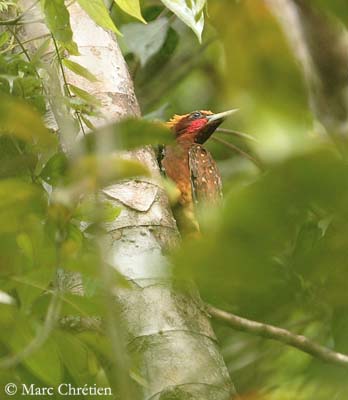
HABITAT:
Chestnut Woodpecker lives in forests with tall trees and closed woodlands, galleries and forest edges, cocoa plantations. It can be found from sea-level to 1000 metres, according to the location, but mainly below 500 metres.
RANGE:
Chestnut Woodpecker is resident and breeding species in South America, from Colombia, Venezuela and the Guiana’s, south to Ecuador, Bolivia, northern Brazil and Trinidad.
BEHAVIOUR:
Chestnut Woodpecker usually feeds alone or in pairs, sometimes in small groups of up to six birds, but it can also be seen in mixed species flock. It forages mainly on lower branches, but also higher, up to sub-canopy.
The bird moves on large branches or trunks where it probes into bark crevices with its bill. It also hammers into arboreal termitaria. It is able to hang upside-down if necessary, in order to reach some fruit.
Chestnut Woodpecker is resident and breeds in its range. It is a diurnal bird, leaving its roost in the early morning and beginning its journey, with reduced activity around midday.
